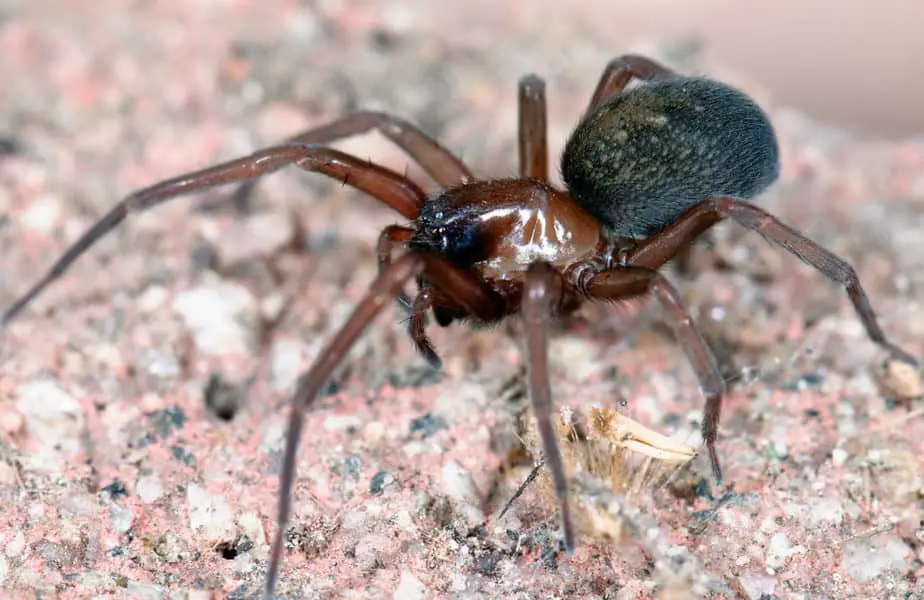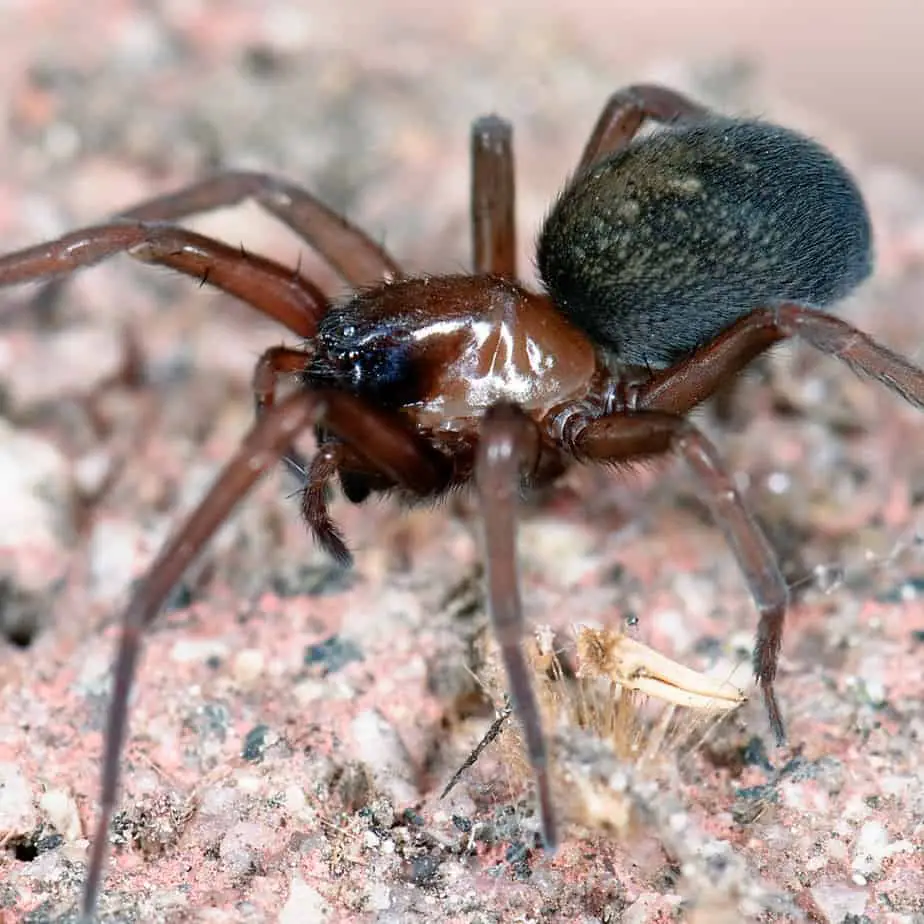Metaltella simoni is a spider species that is commonly often referred to as hacklemesh weaver. This may lead to confusion with some spiders of the genus Amaurobius which are also referred to as hacklemesh weavers and often have a similar appearance. Therefore, we will restrict to the usage of the specific name in this guide which refers only to Metaltella simoni. This species is originally a South American species and has been introduced to the United States in the 1940ies.
Description of Metaltella simoni
The body of Metaltella simoni is usually brown while its abdomen is dark gray or almost black.

At first glance, the spider can look similar to the mouse spider (Scotophaeus blackwalli) that is found in the Western United States. Their ranges only overlap in California.
Here are some identification tips for metaltella simoni:
- The front of the cepahlothorax (head) of Metaltella simoni around the eyes and mouth is usually considerably darker than the rest of the cephalotorax and the legs.
- The cephalotorax is hairless and shiny and has a longitudinal grove through the middle towards the abdomen
- The grey or grey-black abdomen of the female often has lighter spots.
- The male spider has pale or yellow patterns on its back, resembling a herringbone pattern.
- The legs of Metaltella simoni are relatively long and slender
The spider is part of the intertidal spiders family (Desidae). Species of this family occur primarly in Asia, Australia and South America. Next to Metaltella simoni, another introduced species of this spider family is the gray house spider (Badumna longiqua). This spider was introduced to the Western United States from Australia over 100 years ago.
Size
Metaltella simoni is a medium-sized spider with relatively long and slender legs. The body of the larger female reaches a length of 0.3-0.35 in. (8-9 mm) while the male is marginally smaller.
Web
Metaltella simoni spiders are considered cribellate spiders. They spin erratic and tangled webs, similar to those of the Southern House Spider (Kukulcania hibernalis). They feels any vibrations once a prey animal enters the web area and rush towards it to subdue it with a bite and silk.
Bites
A bite from Metaltella simoni is not considered dangerous for humans or larger pets. The spiders is not considered as aggressive and very few bites have been recorded. Potential symptoms are usually limited to local pain and minor swelling, comparable to a bee sting.
Distribution of Metaltella simoni in the USA
Metaltella simoni was introduced to the United States from Argentina in 1944. It was first discovered in Louisiana and has since developed considerable populations throughout the Gulf States and nearby States (Texas, Louisiana, Arkansas, Mississippi, Tennessee, Alabama, Florida, Georgia, South Carolina and North Carolina) as well as in California.
Scientific Classification of Metaltella simoni
- Kingdom: Animalia
- Phylum: Arthropoda
- Subphylum: Chelicerata
- Class: Arachnida
- Order: Araneae
- Infraorder: Araneomorphae
- Family: Desidae
- Genus: Metaltella
- Species: Metaltella simoni
References:
- Taxon details: World Spider Catalogue
- Binomial name from: Keyserling, 1878
- Entomology & Nematology of the University of Florida


Not sure what ..was thinking a brown recluse but no longer positive seems I usually get at least one every year in one of my bathrooms.
Thanks for checking for me.
Hello David, this is definitely not a brown recluse spider. Can you share your location in the U.S. to help with the identification? It might be some species of hacklemesh weaver spider.
Trying to identify this spider. With legs about the size of a quarter or slightly larger. Thinking it could be a hacklemesh weaver, but the banded legs threw me off, as did finding it in a box indoors rather than outside.
I found it in my garage, I believe I have seen a few of them on the property here in Northern Virginia, about 2 miles south of the Potomac River.
Hello Jim, thanks for sharing these photos. This is some type of hacklemesh weaver in the family Amaurobiidae. Possibly Callobius sp.
Found outdoors in eastern PA. Hacklemesh Weaver?
I was just bit by one in Western PA! Definitely felt and swelled like a bee sting.